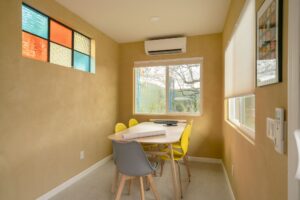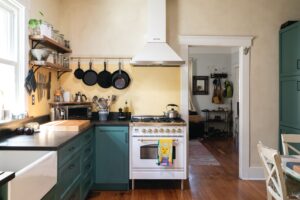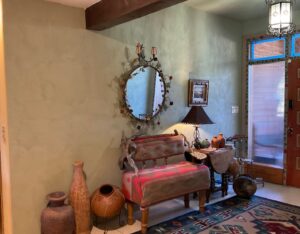
Should You Consider Natural Plaster for Your Walls?
July 26, 2023
Walls are put up to give structure, divide and create space, and provide a sanctuary from the outside. Walls are the canvas of our spaces and we often put a lot of time and energy in to making decisions on how they should look. This has been true since before the commercialization and wide use of paint. However some of the oldest wall finishes are not as common these days even though their benefits far outweigh those of their competitors.
Natural plaster is a type of wall finish made from environmentally friendly and non-toxic materials such as clay or lime. Historically, plasters have been made with ingredients from the earth since the beginning of civilization. Natural plaster offers several benefits for both aesthetics and sustainability, and can perform well in diverse climatic conditions.

Photo by Logan Havens
Clay plaster is made from a mixture of clay, sand, sometimes a binder like casein or wheat paste and sometimes straw or other natural fibers that can be decorative and add tensile strength. It is available in powder form and requires mixing with water before application. It provides a warm, earthy texture and is known for its breathability, moisture regulation, and excellent indoor air quality. You can feel the difference in a space covered in clay plaster, the temperature in a room is stabilized, absorbing and releasing moisture and heat. Clay is grounding and is known for holding negative ions due to its dense molecular structure and shape. Clay also energetically changes the feel of a space. Clay plaster with a lot of straw can be a base coat before putting on lime plaster, especially over strawbale construction and cob construction, this allows a thicker coat to be put on evening out wall surfaces. Clay plaster adheres to a wall through mechanical adhesion, it has no ‘set time’ and that is why it is so repairable. There are a variety of finish options from coarse to textured to polished.
Lime plaster is made from hydrated or hydraulic lime, sand, and water. It can be found in the form of lime putty (a mixture of lime and water that has been pre-hydrated) or a lime powder, either hydrated or hydraulic. Hydrated Lime is the most commonly used and known lime. Hydrated Lime sets only by carbonation (the re-absorption of CO2) and thus, thicknesses are limited. Hydraulic Lime is basically of the same chemical composition as hydrated lime, although hydraulic lime has its initial set with water, much like cement, and a second set by absorption of CO2. Lime putty is an aged, slaked, hydrated lime with an exceptional plasticity which gives you a smoother finish, it is usually just the top finish coat. Lime plaster chemically binds to a wall which is different than most paints, which mechanically bind. This means that the surface it is adhering to needs to be breathable, it cannot be sealed. Lime plaster offers versatility in terms of finish options, ranging from smooth and polished to textured surfaces. It has excellent durability, fire resistance, and can also regulate moisture effectively and it absorbs CO2 out of the air.

Photo by Logan Havens
BENEFITS of NATURAL PLASTER:
Environmentally Friendly: Natural plasters are derived from renewable and abundant resources, making them sustainable choices for wall finishes. They have minimal environmental impact compared to synthetic materials and do not release harmful chemicals or VOCs into the environment.
Breathability and Moisture Regulation: Natural plasters are highly breathable, allowing moisture vapor to pass through their porous structure. This helps regulate indoor humidity levels, preventing mold and mildew growth and creating a healthier living environment.
Aesthetics and Customization: Natural plasters offer a unique and natural aesthetic appeal, adding warmth, texture, and depth to interior spaces. Each can be customized with various application techniques, allowing for creative finishes and decorative effects.
Improved Indoor Air Quality: Natural plasters do not release toxic chemicals or VOCs, contributing to better indoor air quality. They can absorb and neutralize airborne pollutants, promoting a healthier living environment, especially for individuals with allergies or sensitivities.
Thermal Performance: Natural plasters, particularly clay plasters, have good thermal properties. They have a high thermal mass, allowing them to absorb and store heat energy, which helps regulate indoor temperatures and improve insulation and energy efficiency.

APPLICATION and MAINTENANCE:
Application: Natural plaster is typically applied in thin layers using a trowel. It is important to prepare the surface properly, including cleaning, repairing, and possibly applying a suitable base coat or primer. Each layer should be allowed to dry before applying subsequent coats. Clay plaster is more DIY, user friendly, where lime plaster may require a skilled professional for application.
Durability and Longevity: Natural plasters, when properly maintained, can be highly durable and long-lasting. They are less prone to cracking or peeling compared to some conventional paints and can withstand the test of time.
Maintenance: Natural plaster is generally low maintenance. Clay plaster is easily repairable even years later, small cracks or damages can be fixed by re-hydrating the wall and then patching or blending in additional plaster. Unused clay plaster can even be dried out, saved, and rehydrated to make repairs and ensure color matching. Lime plaster gets stronger with age and is considered self-healing, making it very difficult to damage. Although, if damaged it is not as easily repairable as clay plaster and may require re-plastering the whole wall and could require the help of a trained professional. Lime is re-workable only for the first 8-24 hours after application. Regular dusting and cleaning with a soft brush or cloth can help maintain the plaster’s appearance.
Finishes and Techniques: Natural plasters offer a range of finishes and decorative techniques. These can include smooth finishes, textured surfaces, artistic detailing, or even natural pigments for added color. Each technique requires specific application methods and expertise.
It’s important to note that working with natural plaster may require some learning and practice to achieve the desired results. Consulting with professionals experienced in working with natural plasters or attending workshops can provide valuable guidance and ensure a successful outcome. Overall, natural plasters are an excellent option for both modern and traditional architectural designs. They are a sustainable, aesthetically pleasing, and environmentally friendly choice for wall finishes, offering a healthier and more beautiful living environment.
